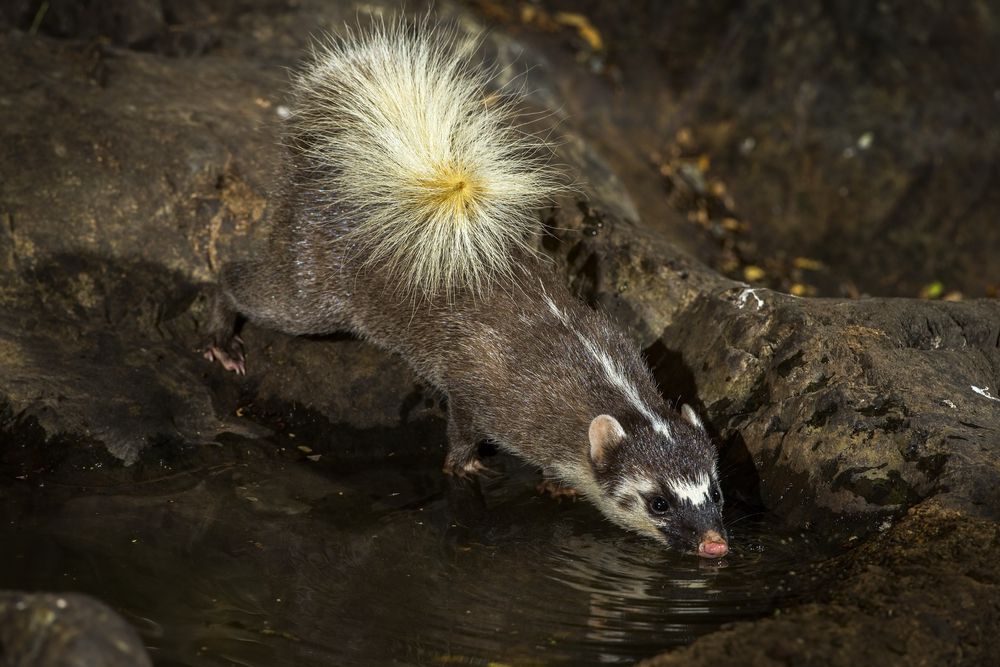
The Elusive Weasel-Badgers: Unmasking the Ferret-Badger
When you hear “badger,” a stocky, powerful digger often comes to mind. And when you hear “ferret,” you might think of a slender, quick-moving mustelid. Now, imagine a creature that beautifully blends traits from both: the Ferret-Badger.
These fascinating animals belong to the genus Melogale and are truly unique members of the badger family (Mustelidae). Found predominantly in Southeast Asia and parts of Eastern Asia, they are smaller and more slender than their more famous badger relatives, possessing a distinct weasel-like elegance.
There are currently five recognized species of ferret-badgers:
- Burmese Ferret-Badger (Melogale personata)
- Chinese Ferret-Badger (Melogale moschata)
- Everett’s Ferret-Badger (Melogale everetti) – Endemic to Borneo
- Javan Ferret-Badger (Melogale orientalis) – Endemic to Java and Bali
- Vietnam Ferret-Badger (Melogale cucphuongensis) – A recently described species
What Makes a Ferret-Badger a Ferret-Badger?
Ferret-badgers are instantly recognizable by their distinctive appearance:
- Slender Body: Unlike the robust build of typical badgers, ferret-badgers are lithe and agile, built for navigating dense undergrowth.
- Long Tail: Their tails are relatively long and bushy, often about half the length of their head and body, contributing to their balanced, almost cat-like movements.
- Masked Face: They typically sport a striking facial pattern, with a dark “mask” around their eyes and a prominent white or yellowish stripe running from their forehead down to their neck. This gives them a mischievous, masked look.
- Small, Rounded Ears: Their ears are small and blend into their fur.
- Partially Retractable Claws: Unlike other badgers, their claws are semi-retractable, a trait more common in civets or even some cats, aiding them in climbing.
Masters of the Night: Their Secretive Lives
Ferret-badgers are primarily nocturnal, making them quite elusive to spot in the wild. They spend their days resting in burrows (which they may dig themselves or take over from other animals), rock crevices, hollow logs, or dense vegetation.
Their nimble bodies and semi-retractable claws make them excellent climbers, a skill that sets them apart from most other badgers. While they forage on the ground, they are equally adept at scaling trees to hunt or escape danger.
What’s on the Menu? An Eclectic Diet
As omnivores, ferret-badgers have a diverse diet, which varies depending on the species and the specific habitat. Their keen sense of smell and agile movements help them track down a variety of food sources:
- Invertebrates: A significant portion of their diet consists of insects (like beetles, crickets, and their larvae), worms, slugs, and snails.
- Small Vertebrates: They’ll opportunistically hunt rodents, frogs, lizards, small birds, and bird eggs.
- Plant Material: Fruits, berries, roots, and tubers also supplement their diet.
Their ability to consume a wide range of foods allows them to adapt to different environments, from dense forests to more open scrublands and even cultivated areas.
Where Do They Roam? From Mountains to Lowlands
Ferret-badgers inhabit a wide range of habitats across their distribution, including:
- Forests: Tropical and subtropical forests, both evergreen and deciduous.
- Grasslands and Shrublands: Areas with dense undergrowth provide good cover.
- Mountainous Regions: Some species are found at high altitudes.
- Agricultural Areas: They can sometimes be found foraging at the edges of farms, which can unfortunately lead to human-wildlife conflict.
Conservation Status and Challenges
The conservation status of ferret-badgers varies by species. The Javan Ferret-Badger is listed as “Vulnerable” by the IUCN, due to its restricted range and habitat loss. Everett’s Ferret-Badger is also of concern. The more widespread species, like the Chinese and Burmese Ferret-Badgers, are currently listed as “Least Concern,” but face ongoing threats.
These threats include:
- Habitat Loss and Fragmentation: Deforestation for agriculture, logging, and infrastructure development are major issues across their range.
- Hunting and Trapping: They are sometimes hunted for their meat, fur, or for use in traditional medicine.
- Illegal Pet Trade: Their unique appearance sometimes makes them targets for the exotic pet trade, which is detrimental to wild populations.
- Road Mortality: As human development expands, ferret-badgers are increasingly at risk of being hit by vehicles.
The Charm of the Unseen
Ferret-badgers are a testament to the incredible diversity of the mustelid family. Their blend of badger tenacity and weasel agility makes them truly unique. Though often unseen and less celebrated than their larger relatives, these masked forest dwellers play an important role in their ecosystems. By learning about them, we can help ensure that these elusive and captivating creatures continue to thrive in the wild.
Have you ever encountered a ferret-badger, or did you learn something new about them today? Share this post with your thoughts on social media to start a conversation!
More photos below ↓







Disclaimer: This blog post is for edutainment purposes only and may not be entirely accurate.






